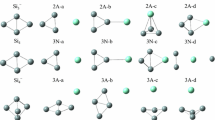Abstract
We have shown recently that the ground state and low-lying energy isomers of the endohedral M@Si16 clusters (M = Sc−, Ti, V+) have a nearly spherical cage-like symmetry with a closed shell electronic structure which conforms them as exceptional stable entities. This is manifested, among other properties, by a large Homo–Lumo gap about 2 eV which suggest the possibility of using these clusters as basic units (superatoms) to construct optoelectronic materials. As a first step in that direction, we have studied in this work, by means of first principles calculations, the trends in the formation of [Ti@Si16] n , [Sc@Si16K] n , and [V@Si16F] n aggregates as their size increases, going from linear to planar to three dimensional arrangements. The most favorable configurations for n ≥ 2 are those formed from the fullerene-like D4d isomer of M@Si16, instead of the ground state Frank–Kasper T d structure of the isolated M@Si16 unit, joined by Si–Si bonds between the Si atoms of the square faces. In all cases the Homo–Lumo gap for the most favorable structure decrease with the size n. Trends for the binding energy, dipole moment, and other electronic properties are also discussed. Several crystal structures constructed from these superatom, supermolecules, and aggregates have been tested and preliminary results are summarily commented.
Similar content being viewed by others
References
Torres M.B., Fernández E.M., Balbás L.C.: Theoretical study of isoelectronic SinM clusters (M = Sc−, Ti, V+; n = 14−18). Phys. Rev. B 75, 205425-1–205425-12 (2007)
Ohara M., Koyasu K., Nakajima N., Kaya K.: Geometric and electronic structures of metal (M)-doped silicon clusters (M = Ti, Hf, Mo and W). Chem. Phys. Lett. 371, 490 (2003)
Koyasu K., Akutsu M., Mitsui M., Nakajima N.: Selective formation of MSi16 (M = Sc, Ti, and V). J. Am. Chem. Soc. 127, 4998 (2005)
Koyasu K., Atobe J., Akutsu M., Mitsui M., Nakajima N.: Electronic and geometric stabilities of clusters with transition metal encapsulated by silicon. J. Phys. Chem. A 111, 42 (2007)
Furuse S., Koyasu K., Atobe J., Nakajima N.: Experimental and theoretical characterization of \({{\rm{MSi}}_{16}^{-},{\rm{ MGe}}_{16}^{-},{\rm{MSn}}_{16}^{-}}\), and \({{\rm{MPb}}_{16}^{-}}\), (M = Ti, Zr, and Hf): the role of cage aromaticity. J. Chem. Phys. 129, 064311 (2008)
Kumar V., Kawazoe Y.: Metal-encapsulated fullerenelike and cubic caged clusters of silicon. Phys. Rev. Lett. 87, 045503 (2001)
Ph. Klar, K. Hirsch, A. Langenberg, F. Lofink, R. Richter, J. Rittmann, M. Vogel, V. Zamudio- Bayer, T. Möller, B.v. Issendorff, T. Lau, Local Electronic Structure of Doped Silicon Clusters: Direct Evidence for the Magic Nature of Endohedrally Doped \({{\rm{VSi}}_{16}^{+}}\), BESSY report: Jahresbericht 2007-2-70416
Reis C.L., Martins J.L., Pacheco J.M.: Stability analisis of a bulk material built from silicon cage clusters: a first principles approach. Phys. Rev. B 76, 233406 (2007)
Kohn W., Sham L.J.: One-particle properties of an inhomogeneous interacting electron gas. Phys. Rev. 145, 561 (1965)
Soler J.M., Artacho E., Gale J.D., García A., Junquera, P. Ordejón J., Sánchez-Portal D.: The SIESTA method for ab initio order-N materials simulation. J. Phys. Condens. Matter 14, 2745 (2002)
Perdew J.P., Burke K., Ernzerhof M.: Generalized gradient approximation made simple. Phys. Rev. Lett. 77, 3865 (1996)
Troullier N., Martíns J.L.: Efficient pseudopotentials for plane-wave calculations. Phys. Rev. B 43, 1993 (1991)
Kleinman L., Bylander D.M.: Efficacious form for model pseudopotentials. Phys. Rev. Lett. 48, 1425 (1982)
Fernández E.M., Torres M.B., Balbás L.C.: Trends in the bonding of the first-row transition metal compounds: V(001) surface, TM-oxide and nitride molecules, and AunTi (2 = n = 7) clusters. Int. J. Quantum Chem. 99, 39 (2004)
Torres M.B., Fernández E.M., Balbás L.C.: Theoretical study of structural, electronic, and magnetic properties of \({{\rm{AuM}}_n^{+}}\), clusters (M = Sc, Ti, V, Cr, Mn, Fe, Au; n = 9). Phys. Rev. B 71, 155412 (2005)
Author information
Authors and Affiliations
Corresponding author
Rights and permissions
About this article
Cite this article
López Laurrabaquio, G., Torres, M.B., Fernández, E.M. et al. Trends in the formation of aggregates and crystals from M@Si16 clusters: a study from first principle calculations. J Math Chem 48, 109–117 (2010). https://doi.org/10.1007/s10910-009-9637-y
Received:
Accepted:
Published:
Issue Date:
DOI: https://doi.org/10.1007/s10910-009-9637-y




